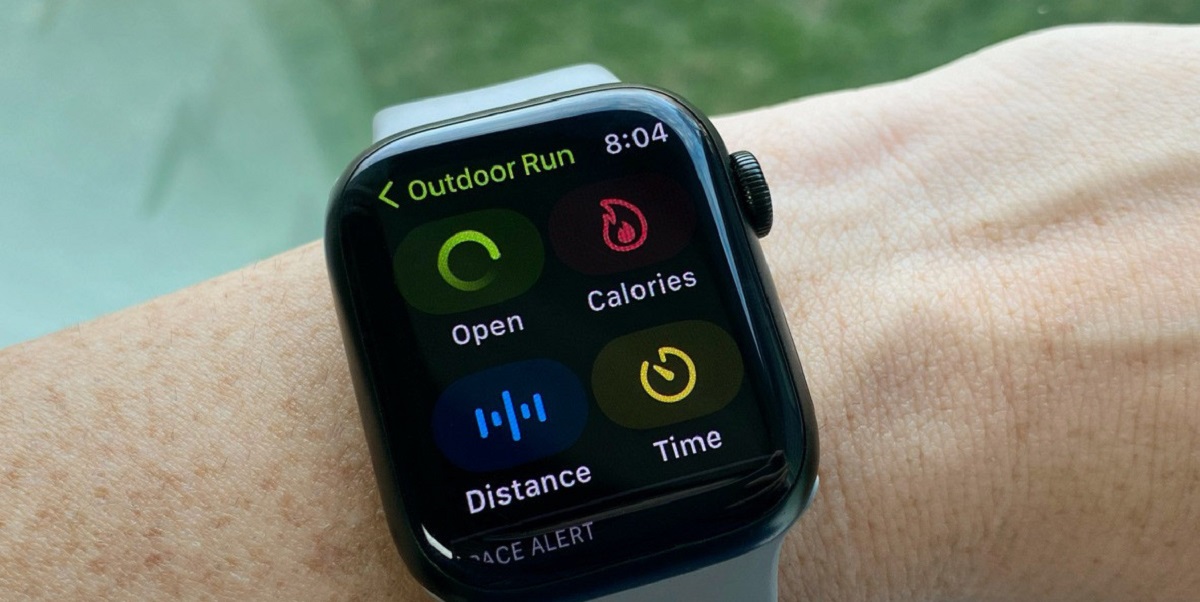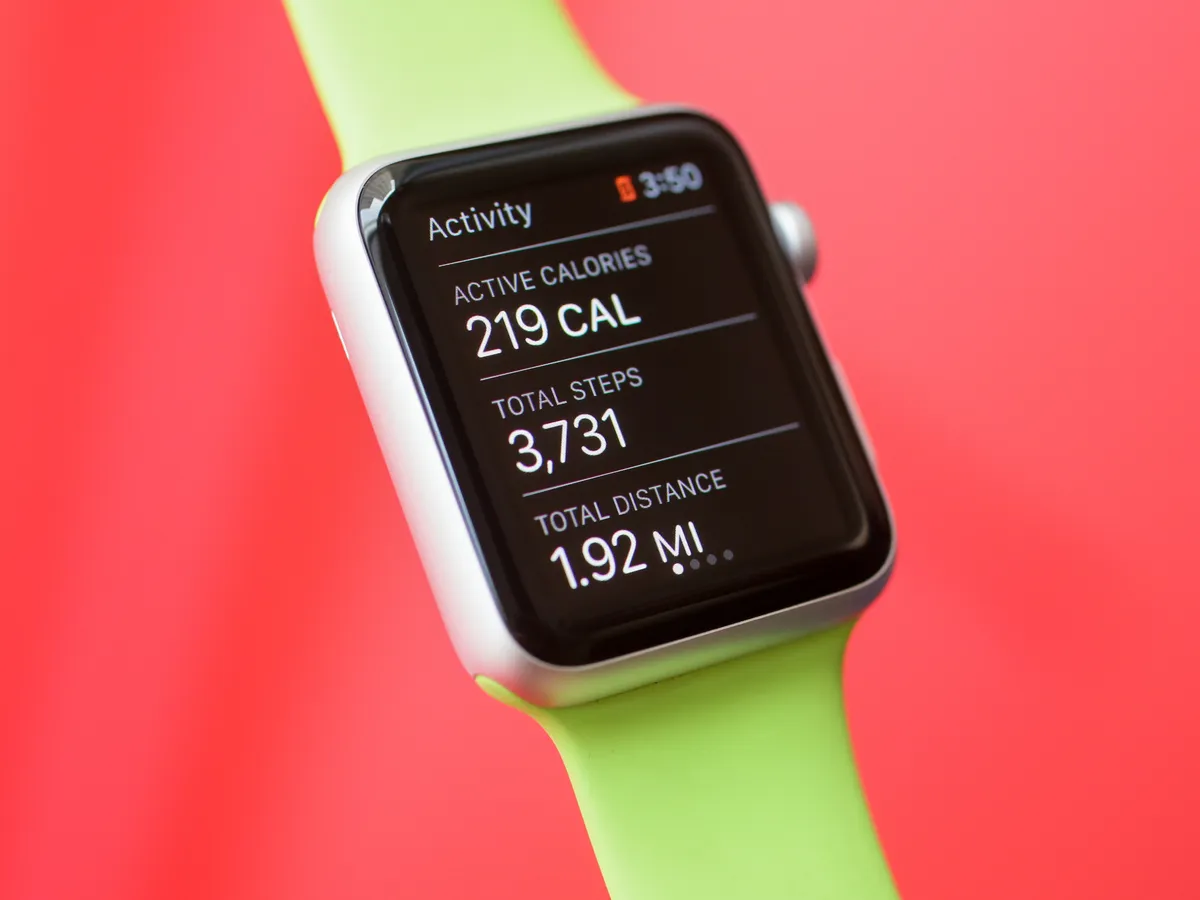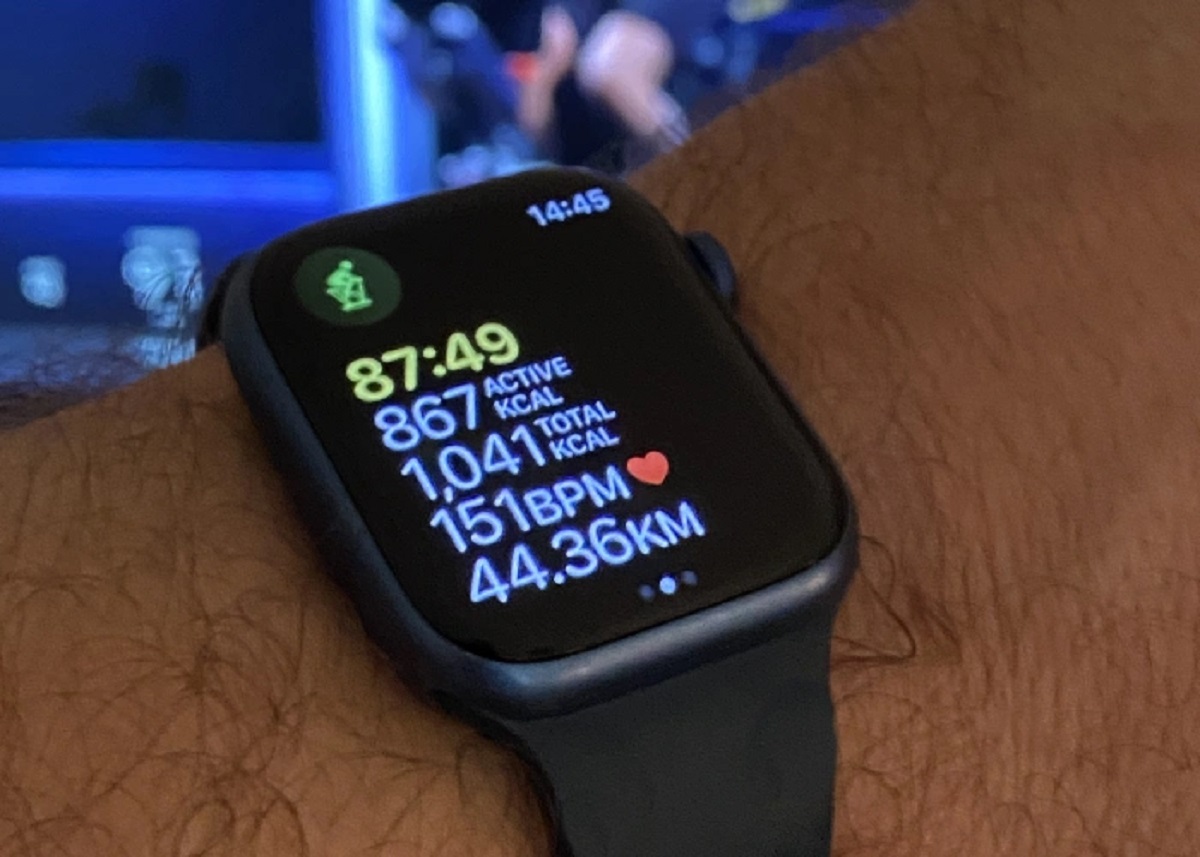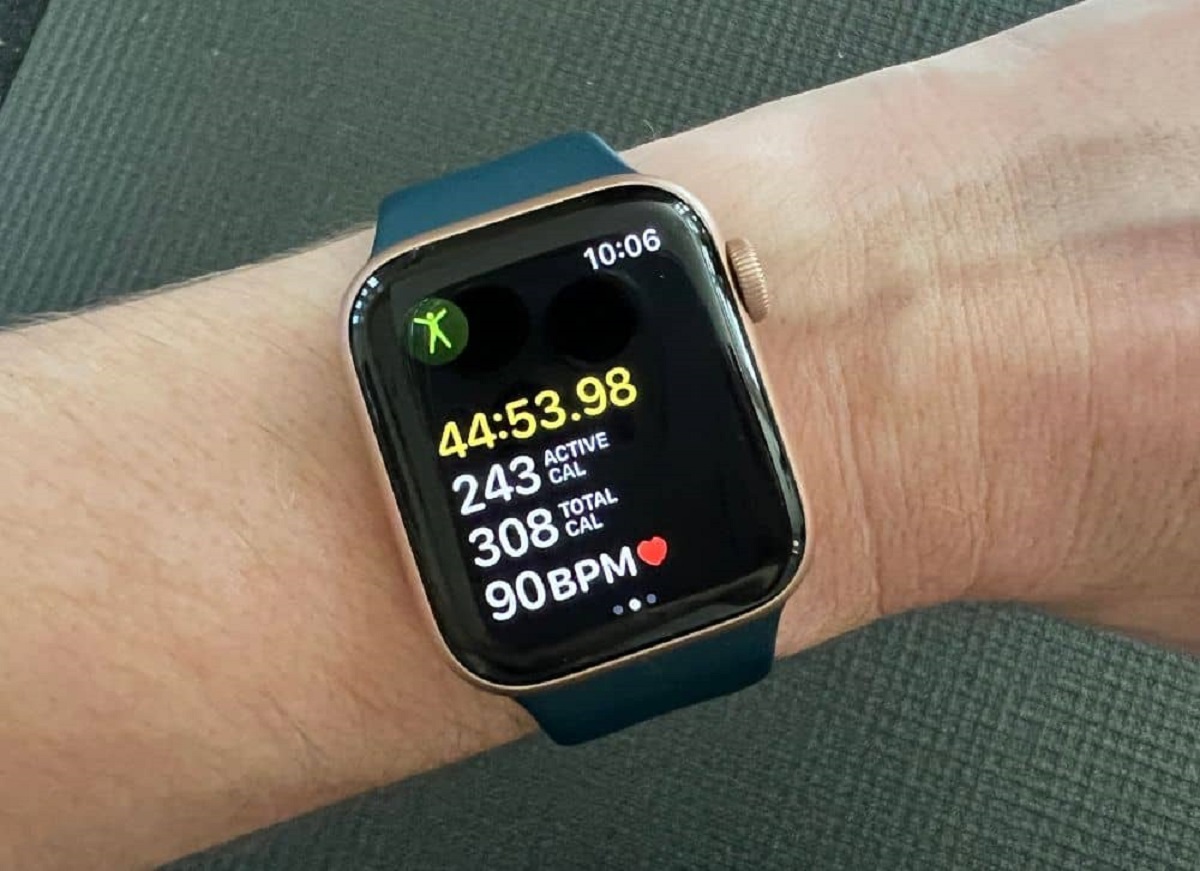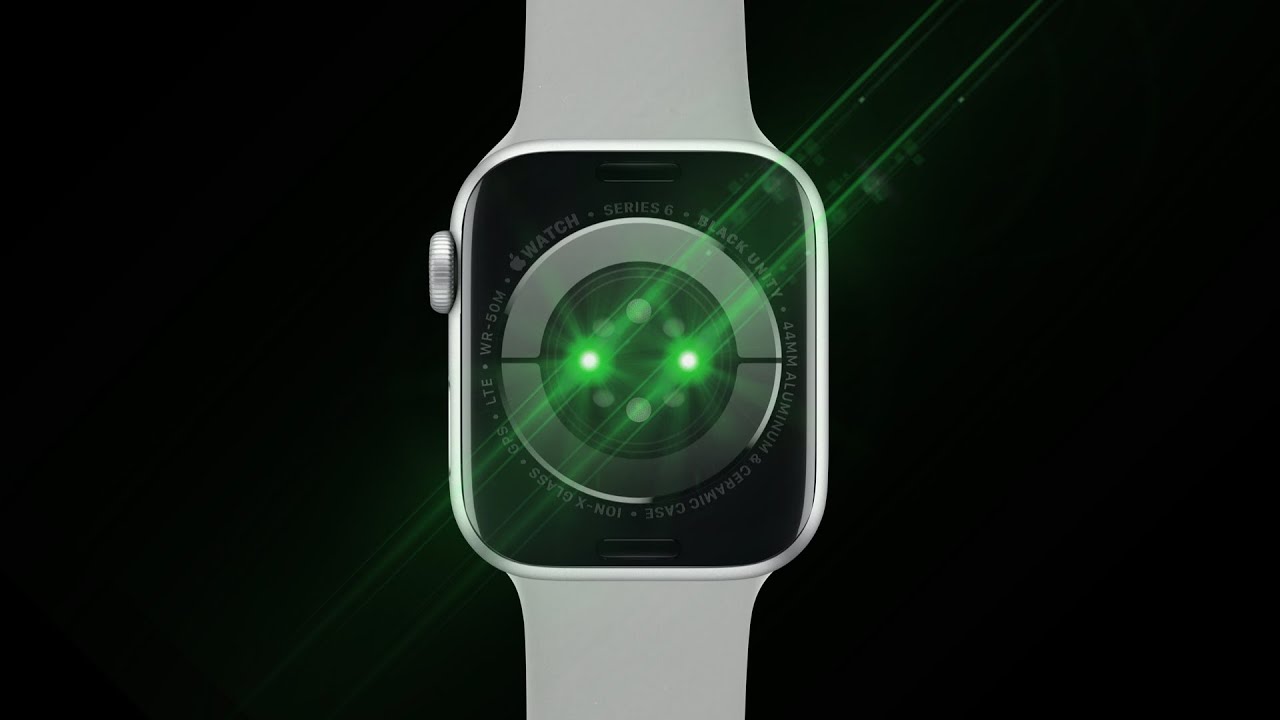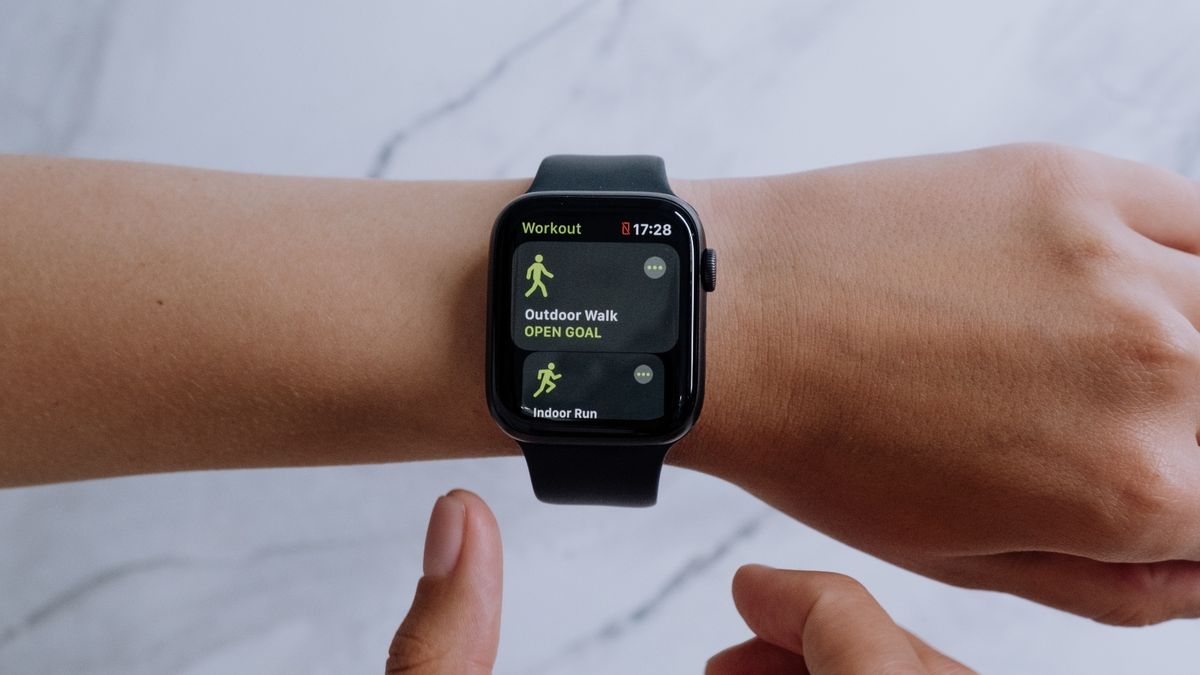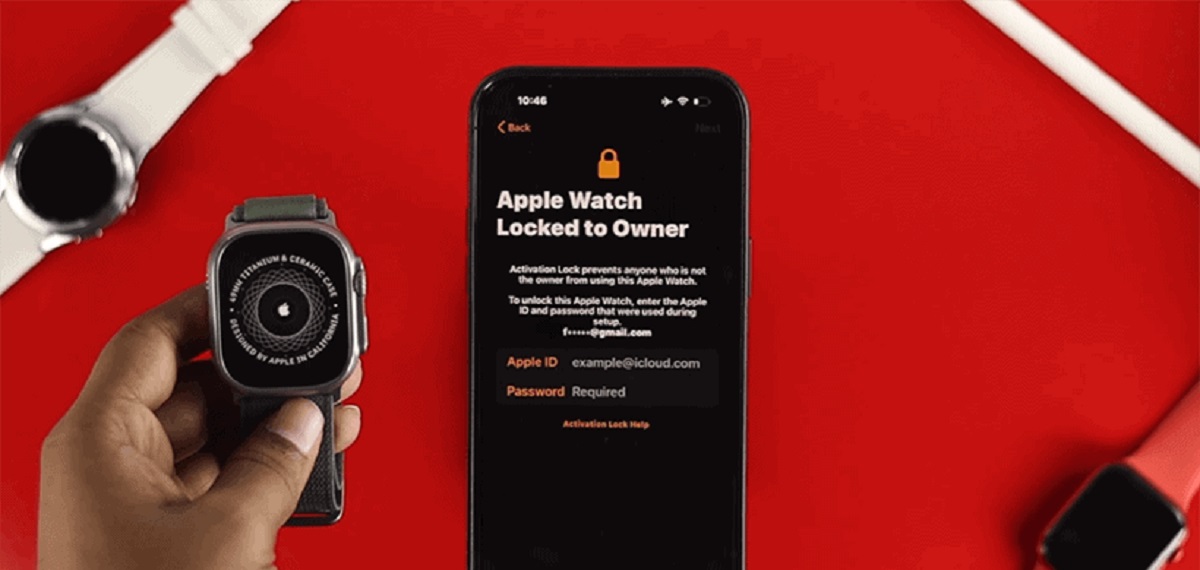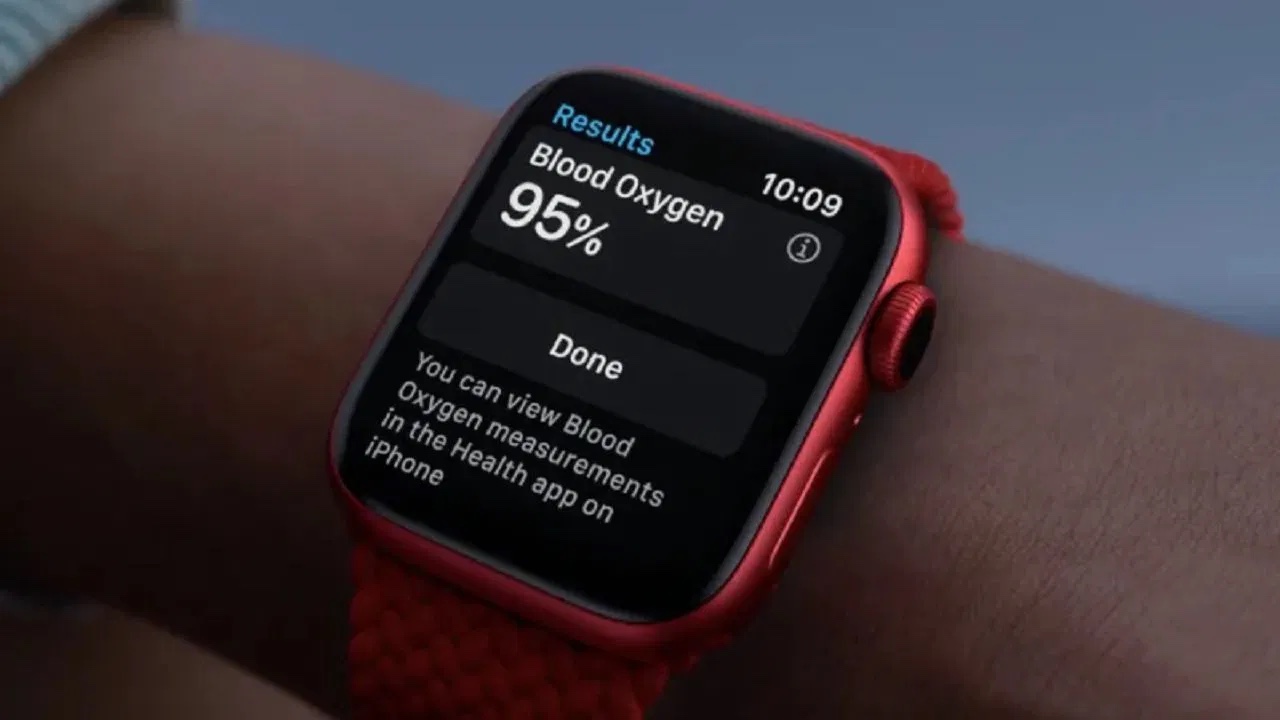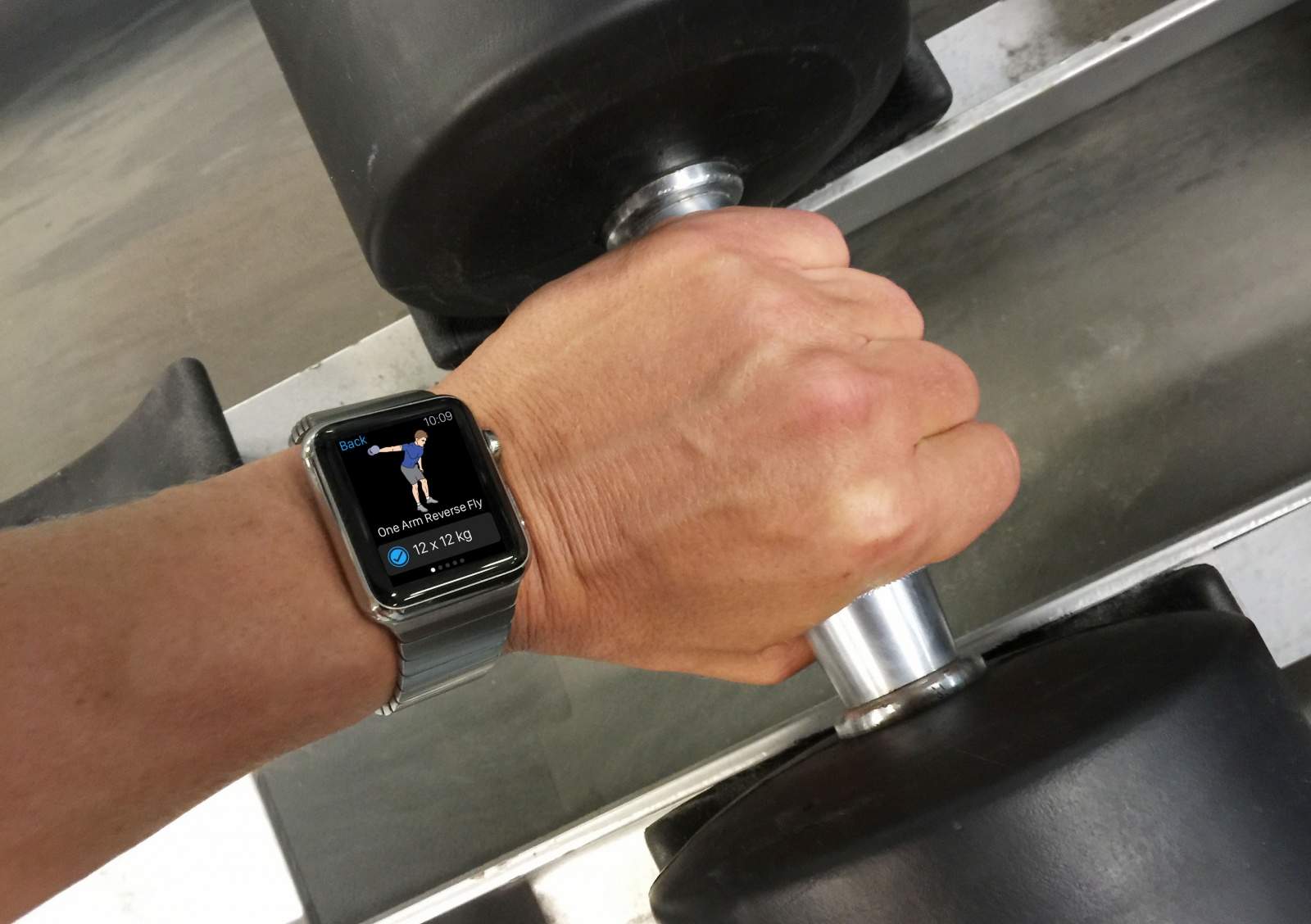Introduction
When it comes to tracking exercise and staying motivated on your fitness journey, the Apple Watch is an invaluable companion. With its advanced technology and comprehensive fitness features, the Apple Watch has revolutionized the way we monitor and measure our physical activities.
Whether you’re a casual walker, a dedicated runner, a swimmer, or an avid cyclist, the Apple Watch offers a range of workout tracking capabilities to suit your needs. With its Workout app and integrated sensors, it can accurately monitor your heart rate, distance, calories burned, and more.
The Apple Watch is equipped with a variety of workout modes, including outdoor walk and run tracking, indoor walk and run tracking, swimming tracking, cycling tracking, and even high-intensity interval training (HIIT) tracking. No matter what activity you engage in, the Apple Watch can provide valuable insights into your performance and progress.
Not only does the Apple Watch track your exercise, but it also motivates you to achieve your fitness goals. The Activity Rings feature encourages you to move, exercise, and stand throughout the day, helping you establish healthy habits and staying active. Additionally, the Apple Watch offers challenges and achievements to keep you motivated and engaged.
Moreover, the Apple Watch can seamlessly integrate with third-party fitness apps, allowing you to consolidate your workout data in one place and access advanced features specific to your preferred fitness app.
In this article, we will dive deep into the various exercise tracking capabilities of the Apple Watch, providing you with a comprehensive understanding of how it measures and monitors your workouts. Whether you’re considering purchasing an Apple Watch or already own one, this guide will help you make the most of its fitness tracking features and optimize your exercise routine.
How Does Apple Watch Track Exercise?
The Apple Watch utilizes a combination of advanced hardware, software, and sensors to accurately track and monitor your exercise. The primary components that enable exercise tracking are the built-in accelerometer, gyroscope, heart rate sensor, and GPS capabilities (in select models).
The accelerometer and gyroscope work in tandem to measure your movement and help determine the type of exercise you’re engaged in. By analyzing the acceleration and rotation of your wrist, the Apple Watch can differentiate between activities such as walking, running, cycling, and swimming.
The heart rate sensor on the back of the watch continuously monitors your heart rate during workouts. This data is essential for measuring your exercise intensity and estimating the number of calories burned.
If you’re using an Apple Watch model with GPS, it can provide more accurate distance and pace measurements by leveraging satellite positioning. This is particularly useful for outdoor activities such as walking, running, and cycling, as it can accurately track your route and calculate metrics like speed and elevation gain.
When you begin a workout, whether through the Workout app or a third-party fitness app, the Apple Watch starts collecting data. It records metrics such as duration, distance, active calories, average and maximum heart rate, and more.
To ensure accurate tracking, it’s important to wear the Apple Watch snugly on your wrist and position it on the top side of your wrist. This allows the sensors to make direct contact with your skin, enhancing the accuracy of heart rate measurements.
Throughout your exercise, the Apple Watch provides real-time feedback on your progress, such as heart rate zones, distance covered, time elapsed, and calories burned. This instant feedback can help you make adjustments to your workout intensity or stay motivated to reach your goals.
After your workout, the Apple Watch generates a summary that includes a detailed breakdown of your performance. You can view this summary on your watch, in the Activity app on your iPhone, or through third-party fitness apps.
With its intelligent exercise tracking capabilities, the Apple Watch empowers you to analyze your workouts, set goals, and make informed decisions on your fitness journey. Its accuracy, combined with the seamless integration of fitness apps and motivational features, makes it an unrivaled fitness companion.
Apple Watch Workout App
The Apple Watch Workout app is the central hub for tracking and monitoring your exercise sessions. It comes pre-installed on every Apple Watch and offers a user-friendly interface that makes it easy to start, track, and finish your workouts.
To access the Workout app, simply tap on the app icon or select it from the app grid on your Apple Watch. Once launched, you’ll be presented with a variety of workout modes to choose from, including outdoor walk, outdoor run, indoor walk, indoor run, cycling, swimming, and more.
Each workout mode is specifically tailored to the corresponding activity, ensuring accurate tracking and relevant metrics. For example, when you select the outdoor run mode, the Apple Watch will utilize its GPS functionality to track your route and provide pace measurements.
During your workout, the Apple Watch displays real-time metrics such as your heart rate, elapsed time, distance covered, and calories burned. This information is updated continuously, allowing you to monitor your progress and make adjustments to your exercise intensity if necessary.
If you have specific goals in mind, such as completing a certain distance or burning a specific number of calories, you can set these targets within the Workout app. The Apple Watch will provide you with visual cues and haptic feedback as you approach and achieve these goals, enhancing your motivation and sense of accomplishment.
In addition to individual workouts, the Apple Watch Workout app also provides the option to create custom workouts or follow pre-designed workout programs. This can be particularly useful if you have a specific training routine or are following a fitness program from a third-party app or fitness trainer.
After completing a workout, the Apple Watch generates a summary that includes key metrics and a detailed breakdown of your activity. You can view this summary right on your watch or access it in the Activity app on your paired iPhone.
The Apple Watch Workout app seamlessly syncs with other health and fitness apps, such as Apple Health and Strava, allowing you to consolidate your workout data in one place. This integration enables you to analyze and track your overall fitness progress and share your achievements with friends and family.
With its intuitive interface, customizable goals, and seamless integration with other apps, the Apple Watch Workout app empowers you to take control of your fitness journey and make every workout count.
Outdoor Walk and Run Tracking
Whether you’re a dedicated runner or enjoy brisk walks in nature, the Apple Watch provides comprehensive tracking capabilities for outdoor walking and running activities. By utilizing its built-in GPS and advanced sensors, the Apple Watch can accurately measure your distance, pace, and route.
When you select the outdoor walk or run mode in the Workout app, the Apple Watch uses its GPS functionality to track your route in real-time. This allows you to view your path on a map and monitor metrics such as distance covered, average pace, and elevation gain.
The Apple Watch also provides audio cues, such as pace alerts and interval announcements, which can help you stay on track and maintain a consistent pace throughout your workout. You can customize these cues based on your preferences and training goals.
During your outdoor walk or run, the Apple Watch continuously monitors your heart rate to give you insight into your exercise intensity and help you optimize your training. By staying within specific heart rate zones, you can tailor your workout to achieve your desired fitness goals and avoid overexertion.
One of the standout features of the Apple Watch is its ability to accurately measure your running cadence – the number of steps per minute. This metric is crucial for improving running efficiency and reducing the risk of injury. The Apple Watch displays your cadence in real-time, allowing you to make adjustments to your running form as needed.
After completing your outdoor walk or run, the Apple Watch provides a detailed summary of your workout, including distance, pace, average and maximum heart rate, and more. This information is accessible on your watch or can be synced to your iPhone’s Activity app for a more in-depth analysis.
With its precise tracking capabilities and real-time feedback, the Apple Watch is the perfect companion for outdoor walking and running workouts. Whether you’re exploring new routes or pushing yourself to achieve new personal records, the Apple Watch helps you stay motivated and improve your performance.
Indoor Walk and Run Tracking
Not all workouts take place outdoors. For those times when you prefer indoor activities or are unable to go outside, the Apple Watch still offers accurate tracking capabilities for indoor walks and runs. By utilizing the built-in accelerometer and gyroscope, the Apple Watch can measure your movements and provide insightful data about your workout.
To track an indoor walk or run, simply select the corresponding mode in the Workout app on your Apple Watch. The device will then rely on its sensors to monitor your movement patterns and estimate distance covered, calories burned, and other relevant metrics.
During your indoor workout, the Apple Watch provides real-time feedback on metrics like elapsed time, heart rate, and pace (if applicable). This information is displayed on the watch face, allowing you to stay informed and motivated throughout your exercise session.
The Apple Watch also offers the ability to calibrate your indoor walking or running workouts to improve accuracy. By doing a short outdoor walk or run, the watch can learn your stride length and use that data to more accurately estimate distance when you exercise indoors.
In addition to tracking your workout data, the Apple Watch allows you to set goals for your indoor walk or run. Whether you’re aiming to achieve a certain distance, calorie burn, or time, the watch will provide you with progress updates and can even give you a gentle tap and message when you reach your goal.
After completing your indoor walk or run, the Apple Watch generates a summary that includes key metrics such as elapsed time, calories burned, average heart rate, and more. This summary can be viewed on your watch or synced to the Activity app on your iPhone for a more comprehensive analysis.
Although you may not have the benefit of GPS tracking for indoor walks and runs, the Apple Watch’s accurate sensors and customizable metrics ensure that you can still monitor your progress, set goals, and stay motivated even when exercising indoors.
Swimming Tracking
If you’re a fan of swimming as a form of exercise, the Apple Watch is equipped with features specifically designed to track your swimming workouts accurately. With its water-resistant design and advanced sensors, the Apple Watch can monitor your swim distance, stroke type, and more.
Before jumping into the water, ensure that you have enabled the Water Lock feature on your Apple Watch. This feature prevents accidental touches on the screen while swimming and activates the swimming tracking functionality.
When you start your swimming workout, select the swim mode in the Workout app. The Apple Watch uses its accelerometer and gyroscope to detect your stroke type, such as freestyle, breaststroke, backstroke, or butterfly. It can also distinguish between open water swim and pool swim.
During your swim, the Apple Watch tracks your distance covered, pace, active calories burned, and heart rate. It can even detect sets and rest intervals for more accurate tracking.
To ensure accurate distance measurement, it’s essential to input the pool length before your swim. The Apple Watch can detect your swim strokes and adjust the distance accordingly based on your strokes and pool length.
Additionally, the Apple Watch provides real-time audio and haptic feedback during your swim workouts. This can alert you to milestones, rest intervals, or progress towards your goal, keeping you motivated and informed even when submerged in water.
After you’ve finished your swim, the Apple Watch displays a summary of your workout, including metrics such as total distance, average pace, average heart rate, and calories burned. You can view this summary on your watch or sync it to your iPhone’s Activity app for a more detailed analysis.
It’s important to note that the Apple Watch’s water resistance is designed for swimmers and can withstand being submerged in water up to 50 meters. However, it’s recommended to avoid activities like scuba diving, high-velocity water skiing, or other water-based activities involving high-velocity water or submersion below shallow depths.
Whether you’re a casual swimmer or an avid competitor, the Apple Watch’s swimming tracking capabilities make it a valuable tool for monitoring your progress and improving your performance in the pool.
Cycling Tracking
For cycling enthusiasts, the Apple Watch offers robust tracking features that allow you to monitor your rides with precision. Whether you enjoy leisurely bike rides or intense cycling sessions, the Apple Watch can track your distance, speed, elevation, and more to provide valuable insights into your workouts.
To begin tracking your cycling workouts, select the cycling mode in the Workout app on your Apple Watch. The watch utilizes its built-in GPS (in GPS-enabled models) to track your route and provide accurate distance measurements. If you’re using a stationary bike or an indoor cycling machine, you can choose the “Indoor Cycle” mode instead.
During your cycling session, the Apple Watch displays real-time metrics such as distance, average speed, elapsed time, and heart rate (if enabled). This information is easily viewable on the watch face, allowing you to monitor your performance without having to stop or slow down.
One of the key features for cyclists is the Apple Watch’s ability to measure and display elevation gain. This allows you to gauge the difficulty of your ride and analyze how elevation changes impact your performance. With this information, you can track your progress and set goals for tackling more challenging terrains.
For improved safety and convenience, the Apple Watch can seamlessly sync with compatible cycling accessories such as speed sensors, cadence sensors, and power meters. This integration provides additional data and insights into your ride, allowing you to fine-tune your training and optimize your cycling efficiency.
After completing your cycling workout, the Apple Watch provides a summary of your ride, including metrics such as total distance, average speed, elevation gain, and calories burned. You can access this summary on your watch or sync it to the Activity app on your iPhone for a more comprehensive analysis.
In addition to tracking your outdoor cycling sessions, the Apple Watch also includes the indoor cycling mode for those times when you’re cycling on a stationary bike or using an indoor cycling machine. The watch employs its sensors to measure your workout intensity, heart rate, and calories burned during these indoor cycling sessions.
Whether you’re a recreational cyclist or a competitive rider, the Apple Watch’s cycling tracking capabilities provide the tools you need to monitor and improve your performance on the bike. With its accurate tracking, real-time feedback, and integration with cycling accessories, the Apple Watch is the perfect companion for cycling enthusiasts of all levels.
High-Intensity Interval Training (HIIT) Tracking
High-Intensity Interval Training (HIIT) has gained popularity for its efficiency and effectiveness in improving cardiovascular fitness and burning calories. The Apple Watch is equipped to track and monitor your HIIT workouts, helping you get the most out of your intense training sessions.
HIIT workouts typically involve alternating periods of high-intensity exercise with short rest or recovery intervals. To track your HIIT workouts using the Apple Watch, you can either select the HIIT workout mode in the Workout app or choose a specific exercise category, such as running or cycling, and manually incorporate HIIT intervals into your workout.
During your HIIT session, the Apple Watch uses its sensors, including the built-in heart rate monitor, to measure and track your heart rate throughout each interval. This allows you to monitor your exertion level and ensure that you’re pushing yourself to the intended intensity.
The Apple Watch also displays real-time feedback, such as time remaining in the current interval and time elapsed in the overall workout, helping you stay on track and maintain the appropriate work-to-rest ratio for your HIIT routine.
Additionally, through the Workout app, you have the option to customize your HIIT workout by setting specific goals or targets. For example, you can specify the number of intervals, duration of each interval, or even set calorie burn goals. The Apple Watch will provide visual and haptic feedback as you reach and surpass these goals, enhancing your motivation and focus during your HIIT workouts.
After completing your HIIT session, the Apple Watch generates a workout summary that includes metrics such as total workout duration, active and total calories burned, average and maximum heart rate, and more. This summary can be viewed on your watch or synced to your iPhone’s Activity app for a comprehensive analysis of your HIIT performance.
The Apple Watch’s accurate heart rate monitoring, real-time feedback, and customizable goals make it an excellent tool for tracking and optimizing your HIIT workouts. Whether you’re sprinting, jumping, or performing bodyweight exercises, the Apple Watch empowers you to monitor your intensity, push your limits, and achieve your fitness goals with each intense interval.
Heart Rate Monitoring during Exercise
Heart rate monitoring is a crucial aspect of tracking and optimizing your exercise routine, and the Apple Watch excels in providing accurate and real-time heart rate data during your workouts. The device’s built-in heart rate sensor continuously measures your heart rate, giving you valuable insights into your exercise intensity and helping you make informed decisions about your training.
During any type of exercise, whether it’s walking, running, cycling, or HIIT, the Apple Watch monitors your heart rate in real-time. This information is displayed on the watch face, allowing you to stay in tune with your body’s response to the activity and adjust your intensity accordingly.
By keeping track of your heart rate during exercise, you can identify the different heart rate zones you’re in, such as fat-burning, cardio, and peak zones. This helps you gauge the effectiveness of your workouts and ensures that you’re staying within your target heart rate range for optimal results.
The Apple Watch also provides the option to set heart rate alerts, allowing you to receive notifications when your heart rate goes above or below a preset threshold. This feature can be particularly useful if you have specific heart rate goals or need to stay within a certain range for health or performance reasons.
In addition to real-time heart rate data, the Apple Watch records your average and maximum heart rate for each workout. This information is included in the workout summary and can be accessed on your watch or synchronized with the Activity app on your iPhone for a more detailed analysis.
For activities that require accurate heart rate monitoring, such as HIIT or interval training, the Apple Watch’s heart rate sensor ensures that you receive precise information throughout each interval. This enables you to push yourself to the appropriate intensity and optimize your training sessions.
It’s important to note that for workouts involving activities with wrist-based movements, such as weightlifting or certain exercises using fitness equipment, the heart rate may not be as accurate due to potential interference. In such cases, using a compatible chest strap heart rate monitor can provide more accurate readings.
Heart rate monitoring during exercise is an essential tool for understanding your body’s response to physical exertion and optimizing your training. With its advanced heart rate sensor and real-time monitoring capabilities, the Apple Watch provides the data you need to make informed decisions and maximize the effectiveness of your workouts.
Calorie Burn Calculation
Accurately estimating the number of calories burned during exercise is essential for tracking your energy expenditure and maintaining a balanced fitness routine. The Apple Watch utilizes advanced algorithms, combined with data from sensors like the heart rate monitor, to provide a reasonably accurate calculation of calorie burn during your workouts.
The Apple Watch takes into account various factors to calculate calorie burn, including your gender, age, height, weight, heart rate, and the intensity of your exercise. By continuously monitoring your heart rate during a workout, the Apple Watch can estimate the energy expended based on the intensity and duration of the activity.
The heart rate data is cross-referenced with the profile information you provide, allowing the Apple Watch to create a more personalized and accurate estimate of your calorie burn. Over time, the watch’s algorithms also factor in your fitness level and individual metabolic rate, further improving the accuracy of the calorie calculations.
It’s important to note that calorie burn calculations are estimations and can vary from person to person due to differences in metabolism and individual physiology. However, the Apple Watch strives to provide reliable and useful estimates based on the available data and algorithms.
The Apple Watch also considers factors beyond exercise when calculating your calorie burn. It takes into account your basal metabolic rate (BMR), which is the energy your body needs at rest, to provide a more comprehensive view of your overall daily calorie burn. This allows you to track your total energy expenditure, including both exercise-related and non-exercise-related activities.
In addition to a workout-specific calorie burn calculation, the Apple Watch also provides a total calorie burn summary for the entire day. This includes the calories burned from activities such as walking, standing, and even basic movements throughout the day, providing you with a holistic view of your daily energy expenditure.
It’s important to keep in mind that while the Apple Watch’s calorie burn calculation is a useful tool for tracking your energy expenditure, it’s not a definitive measure of the exact calories burned. This estimation should be used as a reference point to help you stay aware of your activity levels and make informed decisions about your overall health and fitness.
By providing reasonably accurate calorie burn calculations, the Apple Watch assists you in monitoring and managing your energy expenditure during exercise, helping you stay on track with your fitness goals and maintain a healthy lifestyle.
Activity Rings and Goals
The Apple Watch Activity Rings and Goals feature is designed to encourage a more active and healthier lifestyle by tracking your daily movement and setting personalized goals. The three rings – Move, Exercise, and Stand – provide a visual representation of your daily activity and motivate you to achieve and maintain an active routine.
The Move ring represents the number of active calories burned throughout the day. It fills up as you make progress towards your daily calorie burn goal. The Exercise ring tracks the duration of your activity and encourages you to complete at least 30 minutes of exercise each day. The Stand ring focuses on reducing sedentary behavior, reminding you to stand up and move around for at least one minute every hour.
By default, the Apple Watch sets achievable goals for each ring based on your profile information and activity level. However, you have the flexibility to customize these goals to better align with your fitness aspirations. Whether you want to increase your daily calorie burn, exercise time, or stand more frequently, you can adjust the goals to suit your specific needs.
Throughout the day, the Apple Watch provides visual feedback to keep you updated on your progress towards completing the activity rings. As you fill up each ring, you’ll receive a sense of accomplishment and motivation to stay active. Closing all three rings signifies that you’ve achieved your daily activity goal.
In addition to the activity rings, the Apple Watch offers notifications and reminders to help you stay on track. It sends gentle nudges when you’ve been inactive for too long, prompts you to complete your hourly stand goal, and provides encouragement when you’re close to reaching a milestone or goal.
The Activity Rings and Goals feature is not limited to just exercise and movement. It also takes into account other activities throughout the day, such as walking, cleaning, or even taking the stairs, to contribute to your overall activity level. This promotes a holistic approach to active living and encourages you to incorporate movement into your daily routine.
You can view your activity data in detail by accessing the Activity app on your iPhone. It provides a comprehensive summary of your daily, weekly, and monthly activity, allowing you to track your progress and identify trends or areas for improvement.
By using the Activity Rings and Goals feature, the Apple Watch helps you establish and maintain healthy habits, stay accountable to your fitness goals, and embrace a more active and balanced lifestyle.
Apple Watch Challenges and Achievements
The Apple Watch Challenges and Achievements feature adds an element of fun and motivation to your fitness journey. It provides various challenges and milestones to strive for, pushing you to go further and reach new fitness achievements.
One of the challenges offered by the Apple Watch is the Monthly Challenge. Each month, you’ll receive a new goal based on your past activity levels. This goal may involve completing a specific number of exercise minutes, burning a certain number of calories, or closing your activity rings for a set number of days. The Monthly Challenge keeps you engaged and motivated by giving you something to work towards throughout the month.
In addition to the Monthly Challenge, the Apple Watch also offers special challenges on significant occasions. These challenges could be tied to holidays like Thanksgiving or New Year’s, or even events like Earth Day. Participating in these challenges encourages you to maintain your activity level and stay committed to your fitness routine, even during busy times or holidays.
As you progress in your fitness journey, the Apple Watch rewards you with achievements for reaching certain milestones or completing specific activities. These achievements are virtual badges that are earned by accomplishing fitness goals, overcoming challenges, or hitting notable benchmarks. Examples of achievements include completing a certain number of workouts, reaching a specific calorie burn target, or setting a new personal record in an activity. These achievements provide a sense of accomplishment and can serve as a reminder of your hard work and dedication.
The Apple Watch also features Activity Sharing, allowing you to compete and compare your activity with friends and family. You can invite others to share their activity data with you, and vice versa, creating a supportive and motivating community. By seeing each other’s progress, engaging in friendly competitions, and celebrating achievements together, you can enhance your motivation and accountability.
All of your challenges, achievements, and progress towards goals can be viewed in the Activity app on your iPhone. This allows you to track your accomplishments over time and reflect on your fitness journey.
The Apple Watch challenges and achievements feature fosters a sense of accomplishment, competition, and camaraderie in your fitness endeavors. It keeps you engaged, motivated, and excited about pursuing your health and wellness goals with the support of your Apple Watch community.
Third-Party Fitness Apps and Integration
The Apple Watch seamlessly integrates with a wide range of third-party fitness apps, allowing you to expand your fitness tracking capabilities and access specialized features and workouts. This integration enhances the overall versatility and utility of your Apple Watch as a fitness companion.
By connecting compatible fitness apps to your Apple Watch, you can track and monitor various activities beyond what the built-in Workout app offers. Whether you’re into specific sports, targeted training programs, or unique exercise routines, there’s likely a third-party app that suits your needs.
Popular fitness apps, such as Strava, Nike Run Club, MyFitnessPal, and Runtastic, offer Apple Watch compatibility. These apps allow you to sync your exercise data from the Apple Watch, providing a unified platform to analyze and track your fitness progress.
With third-party apps, you can take advantage of specialized functionality. For example, if you’re a cyclist, apps like Zwift or Strava provide advanced cycling metrics, route planning, and virtual training experiences. Yoga enthusiasts can find apps with guided yoga sessions and pose libraries, while HIIT lovers can utilize apps that provide a range of high-intensity interval workouts.
Integration with third-party fitness apps also enables you to benefit from extended features and community support. For instance, some apps offer interactive challenges, coaching, and even social features to connect with other fitness enthusiasts. This enhances your motivation and makes your fitness journey more enjoyable and engaging.
When you use a third-party fitness app on your Apple Watch, your workout data seamlessly syncs with the Health app on your iPhone. This consolidation of data allows you to have a comprehensive overview of your health and fitness metrics all in one place.
Furthermore, your data from third-party apps can contribute to the Activity Rings on your Apple Watch. This means that workouts tracked by third-party apps count towards your daily exercise and move goals, helping you achieve a balanced and active lifestyle.
With the ability to integrate with third-party fitness apps, the Apple Watch becomes a versatile fitness tracking device. Whether you’re looking for specialized training, tracking your nutrition, or connecting with a fitness community, there’s an app out there that can enhance your Apple Watch experience and help you achieve your fitness goals.
Tips and Tricks for Optimizing Exercise Tracking on Apple Watch
The Apple Watch offers robust exercise tracking capabilities, and with a few tips and tricks, you can optimize your workouts and get the most out of your Apple Watch fitness experience. Here are some helpful suggestions to enhance your exercise tracking:
- Ensure a proper fit: Wear your Apple Watch snugly on your wrist and position it on the top side for accurate heart rate monitoring and to minimize movement interference.
- Calibrate for outdoor walks and runs: For accurate distance measurement, calibrate your outdoor walk or run by using the GPS capabilities of the Apple Watch and completing a short outdoor walk or run.
- Customize your metrics: Personalize your workout metrics by selecting the relevant data fields to display during your exercise session. Customize the metrics screen to show the information that is most important and relevant to you.
- Use power saving mode for longer workouts: If you’re participating in endurance activities or longer workouts, consider enabling Power Saving Mode to conserve battery life and ensure your Apple Watch lasts for the duration of your exercise session.
- Utilize the water lock feature for swimming: Before swimming, activate the Water Lock feature on your Apple Watch to prevent accidental touches on the screen and enable swimming tracking.
- Opt for a compatible chest strap: If you engage in activities with wrist-based movements or require highly accurate heart rate monitoring, consider using a compatible chest strap heart rate monitor that can sync with your Apple Watch.
- Experiment with different workout modes: Explore the various workout modes available on your Apple Watch to find the most accurate and appropriate tracking for different activities, such as cycling, outdoor walk/run, swimming, or HIIT.
- Take advantage of audio and haptic feedback: Enable and customize audio and haptic cues during your workout to receive real-time updates on milestones, intervals, or progress towards your goals.
- Utilize guided workouts: Take advantage of the Apple Watch’s Guided Workouts feature, which offers a range of pre-recorded workouts led by professional trainers to help you stay motivated and engaged during your exercise sessions.
- Keep your Apple Watch software up to date: Regularly check for software updates and install them to ensure that you have the latest features, bug fixes, and enhancements for optimal exercise tracking performance.
By implementing these tips and tricks, you can enhance the accuracy, functionality, and overall experience of exercise tracking on your Apple Watch. Whether you’re a casual fitness enthusiast or a dedicated athlete, these optimizations will help you make the most out of your workouts and achieve your fitness goals effectively.
Conclusion
The Apple Watch revolutionizes exercise tracking with its advanced features and integration of health and fitness apps. With its accurate sensors, real-time feedback, and customizable goals, the Apple Watch empowers users to monitor and optimize their workouts effectively.
Whether you’re counting steps, tracking distance, monitoring heart rate, or estimating calorie burn, the Apple Watch delivers comprehensive data to help you measure and analyze your exercise performance. The Workout app provides a wide range of workout modes, ensuring accurate tracking for different activities.
The Activity Rings and Goals feature encourages a more active lifestyle by visualizing your daily activity and motivating you to achieve daily movement, exercise, and standing goals. Additionally, the Apple Watch challenges and achievements add a fun and competitive element to your fitness journey.
Integration with third-party fitness apps expands the Apple Watch’s capabilities, allowing users to access specialized workouts, track additional metrics, and participate in fitness communities. The seamless sync between the watch and associated apps enables a comprehensive view of your fitness progress.
To optimize exercise tracking, it’s crucial to ensure a proper fit, calibrate outdoor walks and runs, and use specialized modes for different activities. Customizing metrics, enabling power-saving mode, and taking advantage of audio and haptic feedback enhances the exercise experience.
In conclusion, the Apple Watch is a powerful fitness companion that offers accurate exercise tracking, personalized goals, challenges, and achievements. With its diverse features, seamless integration with third-party apps, and customization options, the Apple Watch empowers users to take control of their fitness journey, stay motivated, and achieve their health and wellness goals.







